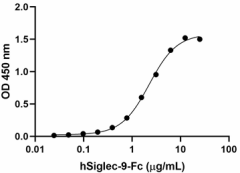- Regulatory Status
- RUO
- Other Names
- Mucin 1, EMA, MCD, PEM, PUM, KL-6, MAM6, MCKD, PEMT, CD227

-

When recombinant human MUC-1 (CD227) is immobilized at 2 µg/mL, it binds recombinant human Siglec-9-Fc chimera in a dose-dependent manner. The ED50 for this effect is 1.6 – 8 µg/mL -

Recombinant human MUC-1 (CD227) was aliquoted in PBS, pH 7 at 0.2 mg/mL and one aliquot was kept at 4°C (control), and another was frozen and thawed four times (4x Freeze/Thaw). After this procedure, the samples were tested for their ability to bind human Siglec-9-Fc in a dose- dependent manner, when recombinant human MUC-1 is immobilized at 2 µg/mL. The ED50 for this effect is 1.6 – 8 µg/mL
| Cat # | Size | Price | Quantity Check Availability | ||
|---|---|---|---|---|---|
| 797304 | 25 µg | $223.00 | |||
| 797306 | 100 µg | $698.00 | |||
MUC-1 (CD227) is a member of the mucin family of proteins, characterized by high carbohydrate content (O-glycosylation) and been part of protective mucous barriers on epithelial surfaces. MUC-1 is bound to the membrane on the apical surface of epithelial cells and consists of a heterodimer formed by alpha (N-terminal) and beta (C-terminal) subunits, which are produced from proteolytic cleavage. The alpha subunit carries cell adhesion properties, while the beta subunit is involved in cell signaling. The MUC-1 gene contains a highly polymorphic variable number repeat domains, and alternative splicing yields multiple transcript variants. One variant, known as Y-LSP, lacks the mucin repeats and has been shown to inhibit tumor growth in mice. MUC-1 aberrant expression, cellular localization, and glycosylation have been associated with carcinomas. High level of MUC-1 expression has been linked with metastasis and poor prognosis. MUC-1, also known as Krebs von den Lungen-6 (KL-6), has been detected at high levels in serum of patients with interstitial lung diseases such as allergic pneumonia and idiopathic pulmonary fibrosis. MUC-1 has been used as a biomarker of acute respiratory distress syndrome (ARDS). Critically ill patients with COVID-19 often progress to ARDS, and MUC-1 has been connected with mortality and severity in patients with COVID-19.
Product Details
- Source
- Human MUC-1 (CD227), amino acid (Pro24-Gly167) (Accession: P15941), with a C-terminal His-TG-8His-GGQ, was expressed in 293E cells.
- Molecular Mass
- The 157 amino acid recombinant protein has a predicted molecular mass of approximately 16.9 kD. The protein migrates at approximately 27 – 30 kD by SDS-PAGE in DTT-reduced and non-reduced conditions. The predicted N-terminal amino acid is Pro.
- Purity
- > 95%, as determined by Coomassie stained SDS-PAGE
- Formulation
- 0.22 µm filtered protein solution is in PBS, pH 7.2.
- Endotoxin Level
- Less than 0.1 EU per µg cytokine as determined by the LAL method
- Concentration
- 25 µg size is bottled at 200 µg/mL. 100 µg size and larger sizes are lot-specific and bottled at the concentration indicated on the vial. To obtain lot-specific concentration and expiration, please enter the lot number in our Certificate of Analysis online tool.
- Storage & Handling
- Unopened vial can be stored between 2°C and 8°C for up to 2 weeks at -20°C for up to six months, or at -70°C or colder until the expiration date. For maximum results, quick spin vial prior to opening. The protein can be aliquoted and stored at -20°C or colder. Stock solutions can also be prepared at 50 - 100 µg/mL in appropriate sterile buffer, carrier protein such as 0.2 - 1% BSA or HSA can be added when preparing the stock solution. Aliquots can be stored between 2°C and 8°C for up to one week and stored at -20°C or colder for up to 3 months. Avoid repeated freeze/thaw cycles.
- Activity
- When recombinant human MUC-1 (CD227) is immobilized at 2 µg/mL, it binds recombinant human Siglec-9-Fc chimera in a dose-dependent manner. The ED50 for this effect is 1.6 – 8 µg/mL
- Application
-
Bioassay
- Application Notes
-
BioLegend carrier-free recombinant proteins provided in liquid format are shipped on blue-ice. Our comparison testing data indicates that when handled and stored as recommended, the liquid format has equal or better stability and shelf-life compared to commercially available lyophilized proteins after reconstitution. Our liquid proteins are validated in-house to maintain activity after shipping on blue ice and are backed by our 100% satisfaction guarantee. If you have any concerns, contact us at tech@biolegend.com.
Antigen Details
- Structure
- Heterodimer (alpha and beta subunit)
- Distribution
-
Epithelial cells, alveolar type II cells, adenocarcinomas, human myeloma cells, activated human T cells
- Function
- Immuno-regulatory role in infections, inflammation, and autoimmunity. Cell-cell and cell-extracellular matrix interactions.
- Interaction
- GRB2 (isoform 1), ICAM-1 (core), SRC (cytoplasmic tail), DC-SING (CD209), macrophage galactose lectin (MGL), siglec-1 (CD169), galectin-3, and E-selectin
- Ligand/Receptor
- Siglec-9
- Bioactivity
- Human MUC-1 (CD227) binds to recombinant human Siglec-9-Fc chimera in a dose-dependent manner.
- Cell Type
- Dendritic cells, Epithelial cells, Lymphocytes, Macrophages, Monocytes, T cells
- Biology Area
- Angiogenesis, Cancer Biomarkers, Cell Adhesion, Cell Biology, Immuno-Oncology
- Molecular Family
- Adhesion Molecules, CD Molecules
- Antigen References
-
- Ligtenberg MJ, et al. 1992. J Biol Chem. 267:6171-7.
- Bafna S, et al. 2010. Oncogene. 29:2893-904.
- Zhang L, et al. 2013. Cancer Immunol ImmunoTher. 62:423-35.
- Agrawal A, et al. 2018. Front Immunol. 9:2391.
- Yamaya T, et al. 2021. Respir Investig. 59:596-601.
- Chen H, et al. 2021. Cytokine. 148:155513.
- Gene ID
- 4582 View all products for this Gene ID
- UniProt
- View information about MUC-1 on UniProt.org
